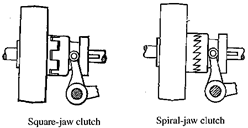←
Automobile Engineering
Types Of The Clutch
Introduction:
Clutch is a mechanism for transmitting rotation, which can be engaged and disengaged. Clutches are useful in devices that have two rotating shafts. In these devices, one shaft is typically driven by a motor or pulley, and the other shaft drives another device.
Basic Types of clutches:
(i) Positive Clutches (ii) Friction clutches
Positive Clutches:

- In this type of clutch, the engaging clutch surfaces interlock to produce rigid joint they are suitable for situations requiring simple and rapid disconnection, although they must be connected while shafts are stationery and unloaded, the engaging surfaces are usually of jaw type.
- The jaws may be square jaw type or spiral jaw type. They are designed empirically by considering compressive strength of the material used.
- The merits of the positive clutches are
- Simple
- No slip
- No heat generated compact and low cost
Friction Clutches:
- Friction Clutches work on the basis of the frictional forces developed between the two or more surfaces in contact. Friction clutches are usually – over the jaw clutches due to their better performance. There is a slip in friction clutch. The merits are
- They friction surfaces can slip during engagement which enables the driver to pick up and accelerate the load with minimum shock.
- They can be used at high engagement speeds since they do not have jaw or teeth.
- Smooth engagement due to the gradual increase in normal force.
Types of the friction clutches:
